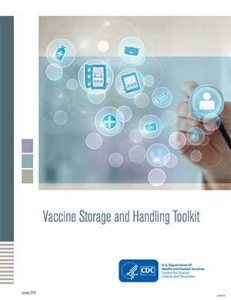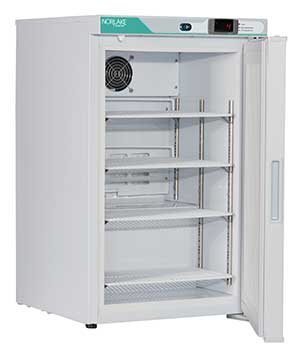
How to Safely Store Vaccines for the Flu Season
With the 2019-2020 flu season upon us it’s time for healthcare facilities to take a close look at their refrigeration equipment for vaccine storage and temperature monitoring. The CDC has published detailed recommendations on how to safely store vaccines in their Vaccine Storage and Handling Toolkit available online. This post summarizes their recommendations on how to safely store vaccines for the 2019-2020 flu season.
- A look at last year’s flu season
- How to select refrigerators to safely store vaccine
- Recommendations for establishing your vaccine inventory
- Other tips to safely store vaccines
A Summary of the 2018-2019 Flu Season
The Centers for Disease Control and Prevention notes that as many as 42.9 million cases of influenza were reported from Oct. 1, 2018 to May 4, 2019 resulting in 20.1 million medical visits and 647,000 hospitalizations. At this posting no estimates have been made for the 2019-2020 season other than while activity is low it is likely to change in the coming months.
How to Select Refrigerators to Safely Store Vaccines
The CDC provides extensive recommendations on the proper storage and handling of vaccines. Vaccine storage temperatures are determined by the manufacturer. Typically most refrigerated vaccines must be stored between 2⁰ and 8⁰C. Frozen vaccines should be stored between -50⁰ and -15⁰C.
The overriding guideline for vaccine for children (VFC)-compliant vaccine storage is that the refrigeration system does not allow temperature excursions above or below the recommended storage temperatures. Set your refrigerator or freezer thermostats at the factory-set or midpoint temperature, which will decrease the likelihood of temperature excursions.
This is because over the years substantial financial losses occur when refrigerators used to store vaccines fail to maintain vaccines at recommended temperatures.
These temperature excursions cause vaccines to lose their potency. In addition to the financial loss there is the inconvenience of calling patients back to be re-vaccinated with uncompromised vaccines.
For example, a February 2019 USA Today article headlined “Vaccines are sometimes stored improperly, reducing their effectiveness” by Carmen Heredia Rodriguez of Kaiser Health News. The article related to temperature control incidents in California and Indiana.
High on the list of CDC recommendations is the use of stand-alone vaccine refrigerators and freezers. That’s because they main the required temperature better than combination refrigerator/freezers. The exception is that combination vaccine refrigerators and freezers are acceptable where each compartment has its own compressor, thermostat, and external door.
The organization notes that stand-alone units can vary in size from pharmaceutical-grade compact, counter-top or undercounter units to full-size units. Not recommended under any circumstance are dormitory-type refrigerators. The CDC goes so far as to say such equipment is prohibited for storing VFC or other vaccines purchased with public funds.
Recommendations for Establishing your Vaccine Inventory
You can calculate vaccine storage inventory based on past experience.
The CDC suggests keeping a 60-day supply on hand and ordering replacement stock on a 30-day cycle while keeping an eye on expiration dates. These calculations will assist in selecting the capacity of the vaccine refrigerator you need.
Compliant vaccine refrigerators come in a variety of sizes. An example ideal for smaller clinics is the 2.5 cu.ft. Norlake PR031WWW-0 solid door freestanding/undercounter cycle-defrost refrigerator. Clinics requiring larger storage capacity might want to consider the Nor-Lake PRF072WWWG/0A combination unit with a 5.2 cu.ft. glass door vaccine refrigerator and separate but co-mounted 1.3 cu.ft. freezer.
The glass door is particularly advantageous because practitioners can see vaccine inventory without opening the door and admitting ambient air.
There are several other vaccine refrigerator and vaccine freezer options available from Tovatech meeting current CDC requirements for vaccine storage and monitoring.
Vaccine Storage Tips
Regardless of the capacity of your vaccine refrigerator or freezer there are certain “must do’s” to keep in mind:
- A full unit does a better job of maintaining the temperature, but do not overfill. Allow room for air circulation.
- Replace removed refrigerator stock with pre-chilled water bottles.
- Replace removed freezer stock with bottles of frozen water.
- Post a note that food and beverages have no place in a vaccine storage unit.
- Keep contents in their original packages, store with early expiration dates toward the front.
- Allow room for circulation between containers, and keep contents 2-3 inches from the walls and back of the unit.
- If your unit has on-door shelves fill them with chilled or frozen water bottles, not vaccines.
- While the CDC recommends continuous digital data recording systems, nothing beats manually recording vaccine temperatures at the beginning and end of the day. Assign personnel to perform this task. This also provides an opportunity to monitor vaccine stock.
For more information on keeping track of vaccine storage temperatures check our post on how to comply with CDC vaccine storage temperature monitoring.
Please contact the scientists at Tovatech for more information on selecting the proper vaccine refrigeration equipment for your practice. We also suggest you download the CDC’s Vaccine Storage and Handling Toolkit.


